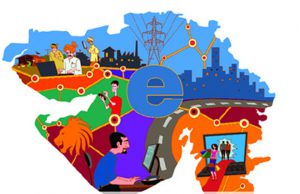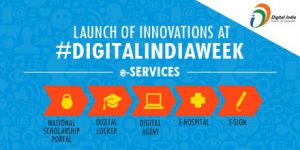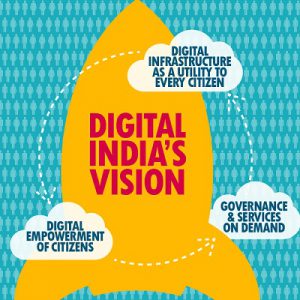Harvard Business School (SPNM), MBA: SP Jain Institute of Management & Research, Master of Information Technology, Virginia Tech.

Digital India is a campaign launched by the Government of India (GOI) to ensure that Government services are made available to citizens electronically by improved online infrastructure and by increasing Internet connectivity or by making the country digitally empowered in the field of technology.
Digital India was launched on 1 July 2015 by Prime Minister Narendra Modi. The initiative includes plans to connect rural areas with high-speed internet networks. The vision of Digital India programme is inclusive growth in areas of electronic services, products, manufacturing and job opportunities, etc and it is centered on three key areas – Digital Infrastructure as a Utility to Every Citizen, Governance & Services on Demand and Digital Empowerment of Citizens.
The Government of India entity Bharat Broadband Network Limited which executes the National Optical Fibre Network project will be the custodian of the Digital India (DI) project. BBNL had ordered United Telecoms Limited to connect 250,000 villages through GPON to ensure FTTH based broadband. This will provide the first basic setup to achieve towards Digital India and is expected to be completed by 2017. The government is planning to create 28,000 seats of BPOs in various states and set up at least one Common Service Centre in each of the gram panchayats in the state. The 2016 Union budget of India announced 11 technology initiatives including the use of data analytics to nab tax evaders, creating a substantial opportunity for IT companies to build out the systems that will be required. Digital Literacy mission will cover six crore rural households. It is planned to connect 550 farmer markets in the country through the use of technology.
Learn GDPI topics from the best resources Out of 10% English speaking Indians, only 2% reside in rural areas. Rest everyone depends on their vernacular language for all living their lives. However, as of now, email addresses can only be created in the English language. To connect rural India with Digital India, the Government of India impelled email services provider giants including Gmail, office, and Rediff to provide an email address in regional Languages. However, the email provider companies have shown a positive sign and are working in the same process. An Indian based company, Data Xgen Technologies Pvt Ltd, has launched world’s first free linguistic email address under the name 'DATAMAIL' which allows creating email ids in 8 Indian languages, English; and 3 foreign languages – Arabic, Russian and Chinese. Over a period of time, the email service in 22 languages will be offered by Data XGen Technologies.
WHY DIGITAL INDIA IS IMPORTANT?
Digital India is a large project to be looked forward which benefits India in many ways the core motive is to digitalize India in every sector. Digital India programme is focused on three key ideas the three core components to be looked for forward these include:
- The creation of digital infrastructure
- Delivery of services digitally
- Digital literacy
Other then this it also has benefits like:
- It will help in decreasing crime if applied on a whole.
- It will help in getting things done easily.
- Also, it will help in decreasing documentation.
- Some of the services which will be provided through this desired effort are Digital Locker, e-education, e-health, e-sign, and nationwide scholarship portal

PM Modi's Digital India is a long way to go. PM Modi has been quite vocal about transforming India into a digitally empowered society with his pet project and most talked about initiative lately – Digital India. For those who have been living under the rock, here's a quick brush through Digital India. Earlier this year, PM Narendra Modi launched the 'Digital India week' promising invests as much as Rs 4.5 lakh crore that aims at adding 1.8 million jobs.
All this is aimed at improving electronic connectivity in the nation. While the whole world is talking about India’s Digital initiative, we are no closer to achieving it. Let’s take a quick look at some of the hurdles.
Broadband penetration in India
One of the prime concerns has been broadband penetration. The most recent numbers show how India is down the slippery slope when it comes to broadband. The UN Broadband Commission released 'The State of Broadband' report yesterday just ahead of the forthcoming Sustainable Development Goals Summit.
India ranked 131 out of 189 countries on fixed-broadband subscriptions in 2014, a drop from the 125th rank a year before. India ranked 80 among 133 developing countries on percentage of households with internet in 2014 with a 15.3 percent penetration as compared to the 75th rank and 13 percent penetration in 2013.
The only saving grace is India's 136th rank in individuals using the Internet in 2014, with 18 percent individuals using the net, an improvement over the 142nd rank in 2013 when 15.1 percent individuals used the internet. All in all, there needs to be an increase in online representation, especially in a country like India, that has high linguistic diversity.
Rural connectivity
The government is trying to fix this with the aim to connect about 2.5 lakh village panchayats connected by the end of next year. Another most recent report points out how the total number of broadband-enabled households is slightly more than 1.5 crore – which means a penetration rate of a mere 5 percent.
That’s a real meager number and stepping it up won’t be very quick or easy. Taking broadband to such areas will also mean special value-added services. Moreover, it raises questions like will the lines be laid down effectively, quality of the service and so on.
This is one of the main reasons why rural is jumping onto the mobile Internet bandwagon, bypassing the broadband lines. One of the key announcements to come out of Modi’s second US visit focusses on this aspect. Microsoft’s CEO Satya Nadella has said his company will take lost-cost broadband technology to some five lakh villages across the country. However, this also raises several questions such – haven’t we been talking about 'Make in India'.
This may not be the case when it comes to mobile phones. Going by the most recent numbers from IAMAI, India has added 52 million Internet users in the first six months of the year, taking the total user base to 352 million as on June 30, 2015.
However, 213 million, which means over 60 percent of users, accessed the worldwide web through mobile devices. The number of Internet users has grown over 26% from 278 million in October 2014. The number of mobile Internet users has also grown about 40% from 159 million users in October last year. What’s really interesting in the report is how the Internet in India took more than a decade to move from 10 million to 100 million and a mere 3 years from 100 to 200 million.
However, when it comes to smartphone penetration, we had hit a sudden roadblock. According to IDC, the Indian smartphone market saw a sequential drop for the first time in Q4 of 2014 that ended December 31, 2014. When it comes to fixed broadband, one of the main problems is a low-budget phone is cheaper than a full-fledged computer. And this has been driving mobile connectivity in India. Government-run cyber cafes and post offices for e-services is a great solution, but again, most of these villages are struggling with power cuts. Some other digital initiatives that aim at reducing paperwork and making easy access to knowledge are e-governance and several other websites that have been set-up.
However, do you everyone is aware that they can go to MyGov.in and Twitter to check the new updates by the government. The key here is - awareness, and in several forms and over a long period of time. Today, it’s all about working at the grass-root level to create a viable ecosystem and infrastructure. "With Digital India, the government is trying to create the infrastructure for people in India – urban or rural- and connect 2,50,000 villages with broadband optical connectivity.
The government is trying to bring the infrastructure connectivity environment in each and every village, alongside trying to ensure e-governance, IT skills and eventually Make in India. For instance, broadband access to a panchayat’s room means villagers can video conference with doctors and villages who are not willing to go to the village to offer their services," Dr. Rishi Bhatnagar, author of Enterprise IoT and chairperson at The IET IoT panel, India tells us.
Today, the cost of connectivity, cost of mobility, cost of hardware, device and so on is reducing. We have still a long way to go because it is about how a low-budget phone affordable by a farmer in a remote village will work beyond mere connectivity or how there would be stable fixed broadband connectivity and so on. Nevertheless, it is still a great initiative. After all, we need to start somewhere. However, it is just the start to the 'Digital India' vision, and we have a long way to go.
Read: E-commerce Boon Or Bane



Comments are disabled for now